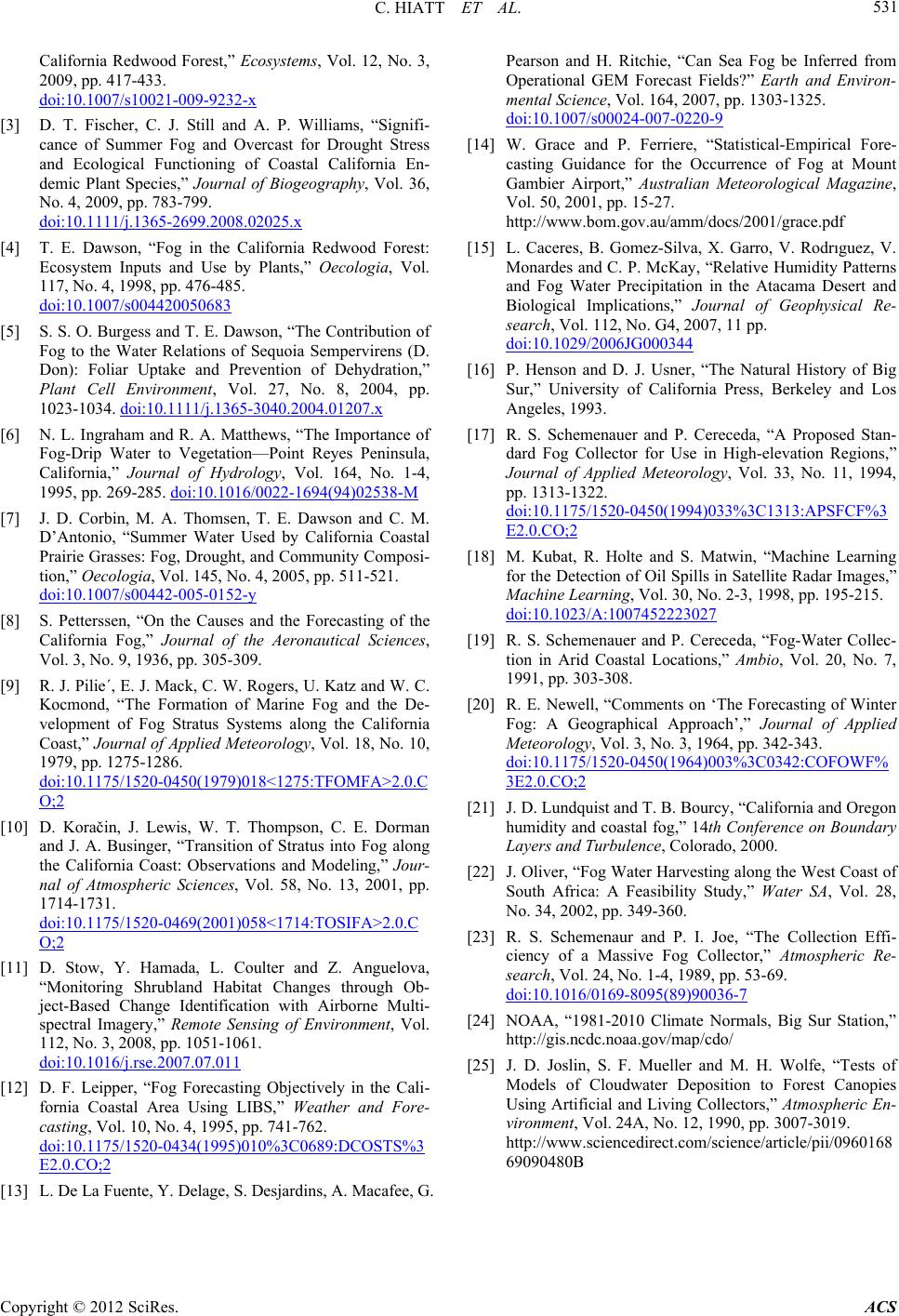
C. HIATT ET AL.
Copyright © 2012 SciRes. ACS
531
California Redwood Forest,” Ecosystems, Vol. 12, No. 3,
2009, pp. 417-433.
doi:10.1007/s10021-009-9232-x
[3] D. T. Fischer, C. J. Still and A. P. Williams, “Signifi-
cance of Summer Fog and Overcast for Drought Stress
and Ecological Functioning of Coastal California En-
demic Plant Species,” Journal of Biogeography, Vol. 36,
No. 4, 2009, pp. 783-799.
doi:10.1111/j.1365-2699.2008.02025.x
[4] T. E. Dawson, “Fog in the California Redwood Forest:
Ecosystem Inputs and Use by Plants,” Oecologia, Vol.
117, No. 4, 1998, pp. 476-485.
doi:10.1007/s004420050683
[5] S. S. O. Burgess and T. E. Dawson, “The Contribution of
Fog to the Water Relations of Sequoia Sempervirens (D.
Don): Foliar Uptake and Prevention of Dehydration,”
Plant Cell Environment, Vol. 27, No. 8, 2004, pp.
1023-1034. doi:10.1111/j.1365-3040.2004.01207.x
[6] N. L. Ingraham and R. A. Matthews, “The Importance of
Fog-Drip Water to Vegetation—Point Reyes Peninsula,
California,” Journal of Hydrology, Vol. 164, No. 1-4,
1995, pp. 269-285. doi:10.1016/0022-1694(94)02538-M
[7] J. D. Corbin, M. A. Thomsen, T. E. Dawson and C. M.
D’Antonio, “Summer Water Used by California Coastal
Prairie Grasses: Fog, Drought, and Community Composi-
tion,” Oecologia, Vol. 145, No. 4, 2005, pp. 511-521.
doi:10.1007/s00442-005-0152-y
[8] S. Petterssen, “On the Causes and the Forecasting of the
California Fog,” Journal of the Aeronautical Sciences,
Vol. 3, No. 9, 1936, pp. 305-309.
[9] R. J. Pilie´, E. J. Mack, C. W. Rogers, U. Katz and W. C.
Kocmond, “The Formation of Marine Fog and the De-
velopment of Fog Stratus Systems along the California
Coast,” Journal of Applied Meteorology, Vol. 18, No. 10,
1979, pp. 1275-1286.
doi:10.1175/1520-0450(1979)018<1275:TFOMFA>2.0.C
O;2
[10] D. Koračin, J. Lewis, W. T. Thompson, C. E. Dorman
and J. A. Businger, “Transition of Stratus into Fog along
the California Coast: Observations and Modeling,” Jour-
nal of Atmospheric Sciences, Vol. 58, No. 13, 2001, pp.
1714-1731.
doi:10.1175/1520-0469(2001)058<1714:TOSIFA>2.0.C
O;2
[11] D. Stow, Y. Hamada, L. Coulter and Z. Anguelova,
“Monitoring Shrubland Habitat Changes through Ob-
ject-Based Change Identification with Airborne Multi-
spectral Imagery,” Remote Sensing of Environment, Vol.
112, No. 3, 2008, pp. 1051-1061.
doi:10.1016/j.rse.2007.07.011
[12] D. F. Leipper, “Fog Forecasting Objectively in the Cali-
fornia Coastal Area Using LIBS,” Weather and Fore-
casting, Vol. 10, No. 4, 1995, pp. 741-762.
doi:10.1175/1520-0434(1995)010%3C0689:DCOSTS%3
E2.0.CO;2
[13] L. De La Fuente, Y. Delage, S. Desjardins, A. Macafee, G.
Pearson and H. Ritchie, “Can Sea Fog be Inferred from
Operational GEM Forecast Fields?” Earth and Environ-
mental Science, Vol. 164, 2007, pp. 1303-1325.
doi:10.1007/s00024-007-0220-9
[14] W. Grace and P. Ferriere, “Statistical-Empirical Fore-
casting Guidance for the Occurrence of Fog at Mount
Gambier Airport,” Australian Meteorological Magazine,
Vol. 50, 2001, pp. 15-27.
http://www.bom.gov.au/amm/docs/2001/grace.pdf
[15] L. Caceres, B. Gomez-Silva, X. Garro, V. Rodrıguez, V.
Monardes and C. P. McKay, “Relative Humidity Patterns
and Fog Water Precipitation in the Atacama Desert and
Biological Implications,” Journal of Geophysical Re-
search, Vol. 112, No. G4, 2007, 11 pp.
doi:10.1029/2006JG000344
[16] P. Henson and D. J. Usner, “The Natural History of Big
Sur,” University of California Press, Berkeley and Los
Angeles, 1993.
[17] R. S. Schemenauer and P. Cereceda, “A Proposed Stan-
dard Fog Collector for Use in High-elevation Regions,”
Journal of Applied Meteorology, Vol. 33, No. 11, 1994,
pp. 1313-1322.
doi:10.1175/1520-0450(1994)033%3C1313:APSFCF%3
E2.0.CO;2
[18] M. Kubat, R. Holte and S. Matwin, “Machine Learning
for the Detection of Oil Spills in Satellite Radar Images,”
Machine Learning, Vol. 30, No. 2-3, 1998, pp. 195-215.
doi:10.1023/A:1007452223027
[19] R. S. Schemenauer and P. Cereceda, “Fog-Water Collec-
tion in Arid Coastal Locations,” Ambio, Vol. 20, No. 7,
1991, pp. 303-308.
[20] R. E. Newell, “Comments on ‘The Forecasting of Winter
Fog: A Geographical Approach’,” Journal of Applied
Meteorology, Vol. 3, No. 3, 1964, pp. 342-343.
doi:10.1175/1520-0450(1964)003%3C0342:COFOWF%
3E2.0.CO;2
[21] J. D. Lundquist and T. B. Bourcy, “California and Oregon
humidity and coastal fog,” 14th Conference on Boundary
Layers and Turbulence, Colorado, 2000.
[22] J. Oliver, “Fog Water Harvesting along the West Coast of
South Africa: A Feasibility Study,” Water SA, Vol. 28,
No. 34, 2002, pp. 349-360.
[23] R. S. Schemenaur and P. I. Joe, “The Collection Effi-
ciency of a Massive Fog Collector,” Atmospheric Re-
search, Vol. 24, No. 1-4, 1989, pp. 53-69.
doi:10.1016/0169-8095(89)90036-7
[24] NOAA, “1981-2010 Climate Normals, Big Sur Station,”
http://gis.ncdc.noaa.gov/map/cdo/
[25] J. D. Joslin, S. F. Mueller and M. H. Wolfe, “Tests of
Models of Cloudwater Deposition to Forest Canopies
Using Artificial and Living Collectors,” Atmospheric En-
vironment, Vol. 24A, No. 12, 1990, pp. 3007-3019.
http://www.sciencedirect.com/science/article/pii/0960168
69090480B